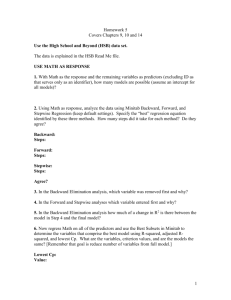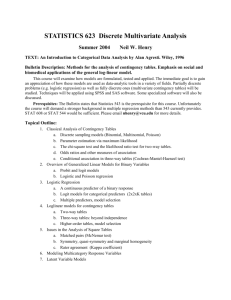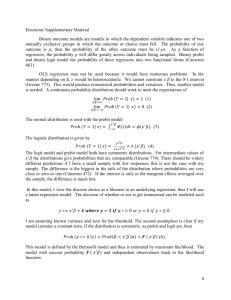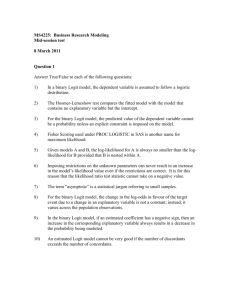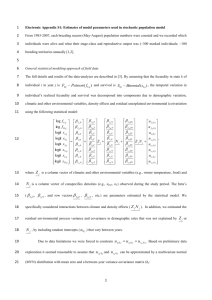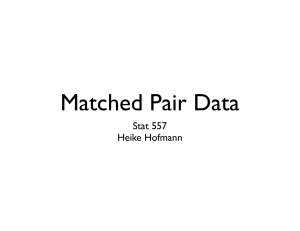SS1502
advertisement
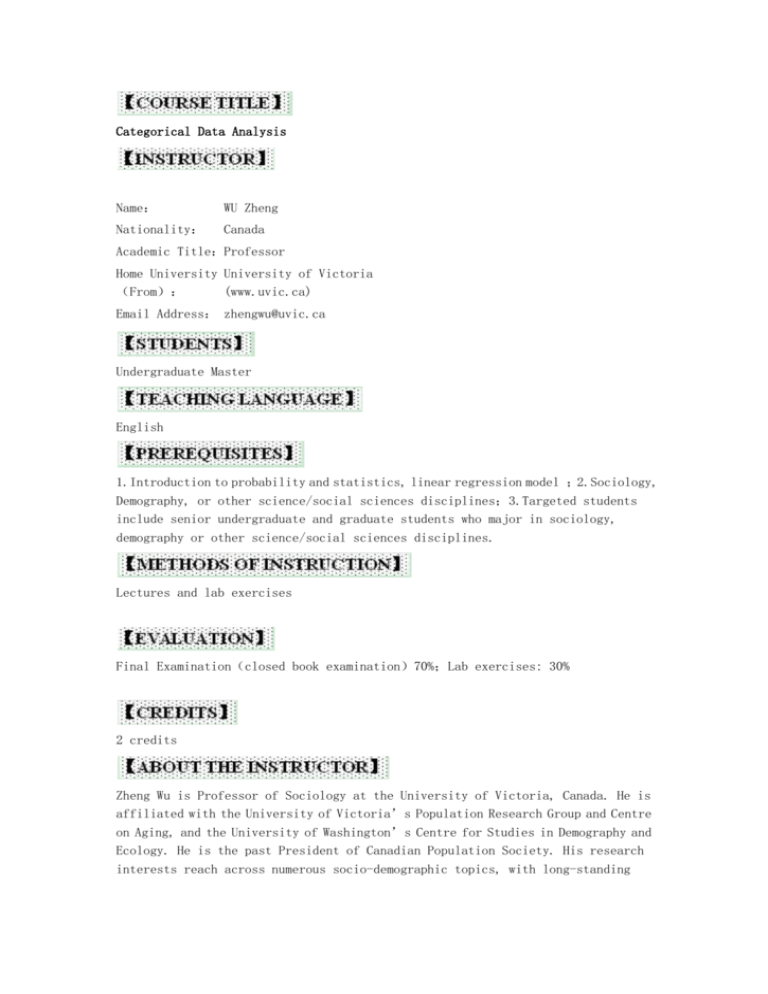
Categorical Data Analysis Name: WU Zheng Nationality: Canada Academic Title:Professor Home University University of Victoria (From): (www.uvic.ca) Email Address: zhengwu@uvic.ca Undergraduate Master English 1.Introduction to probability and statistics, linear regression model ;2.Sociology, Demography, or other science/social sciences disciplines;3.Targeted students include senior undergraduate and graduate students who major in sociology, demography or other science/social sciences disciplines. Lectures and lab exercises Final Examination(closed book examination)70%;Lab exercises: 30% 2 credits Zheng Wu is Professor of Sociology at the University of Victoria, Canada. He is affiliated with the University of Victoria’s Population Research Group and Centre on Aging, and the University of Washington’s Centre for Studies in Demography and Ecology. He is the past President of Canadian Population Society. His research interests reach across numerous socio-demographic topics, with long-standing interest in family demography. Dr. Wu has published extensively in the areas of fertility, union formation and dissolution, aging, health, and immigration. The objective of this course is to introduce statistical methods for analyzing categorical data. The emphasis will be on practical applications rather than statistical theories. It is assumed that students have had at least two one-semester courses in applied statistics at the undergraduate/graduate level, covering probability theory, probability distributions, hypothesis testing, analysis of variance (including dummy variable regression), and regression techniques. 1.Introduction to categorical data analysis:1)Types of categorical variables 2)Review of linear regression 3)Maximum likelihood estimation (MLE) 4) Introduction to generalized linear model (GLM) 2、 The logit model for binary outcomes 1) Binary dependent variables 2)Linear probability model 3)Logistic (logit) regression model 4)Probit model 5)Justifications of logit model 6) Estimation and goodness of fit 3、Loglinear models for contingency tables:1)Introduction to contingency table analysis 2)Two-way tables 3)Odds ratio and log odds ratio 4)Sampling models 5)Loglinear models for two-way tables 6)Normalization 7)Estimation and goodness of fit8)Models for multi-way tables 9)Association models for ordinal variables 10)Introduction to Bayesian statistics4、 Methods for survival data analysis:1) Rates and basic concepts in survival analysis 2)Logistic model 3)Log-rate model 4)The life table 5)Discrete-time event history model 6)Censoring 7)The Kaplan-Meir non-parametric estimate of survival function 8)Failure time models 9)Hazard models 10)Cox’s proportional hazard model 5、Models for ordinal dependent variables:1)Ordinal dependent variables 2)Logit models with different logits 3)Ordered logit model and probit model 4)Poisson model and negative binomial model 6、Multinomial logit model:1)Types of logit models 2)Multinomial logit model 3)Independence from irrelevant alternative (IIA) 4Multinomial logit model and loglinear model 1.Daniel Powers and Yu Xie. 2008. Statistical Methods for Categorical Data Analysis. Second Edition. San Diego, CA: Academic Press. ISBN: 978-0-1237-2562-2. There is a website for the book (https://webspace.utexas.edu/dpowers/www/Powers%26Xie%202nd%20Ed/), which provides the datasets and programming codes for the examples used in the text. 2.Scott Long and Jeremy J. Freese. 2006. Regression Models for Categorical Dependent Variables Using STATA, Second Edition. College Station, TX: STATA Corporation. ISBN: 1-59718-011-4. There is also a website for the book: http://www.indiana.edu/~jslsoc/spost.htm. 1.Clogg, Clifford C. 1982. “Using Association Models in Sociological Research: Some Examples.” American Journal of Sociology 88(1):114-134. 2.Duncan, Otis Dudley. 1979. “How Destination Depends on Origin in the Occupational Mobility Table.” American Journal of Sociology 84:793-803. 3.Gill, J. 2001. Generalized linear models: A unified approach. Thousand Oaks, CA: Sage. 4.Hauser, Robert M. 1980. “Some Exploratory Methods for Modeling Mobility Tables and Other Cross-Classified Data.” Pp. 413-58 in Sociological Methodology, 1980, edited by K. F. Schuessler. San Francisco, CA: Jossey-Bass. 5.Manski, Charles F., and David A. Wise. 1983. College Choice in America. Cambridge: Harvard University Press. 6.Mare, Robert D. 1991. “Five Decades of Educational Assortative Mating.” American Sociological Review 56:15-32. 7.Winship, Christopher, and Robert D. Mare. 1992. “Models for Sample Selection Bias.” Annual Review of Sociology 18:327-350. 8.Wu, Zheng. 2005. “Generalized Linear Models in Family Studies.” Journal of Marriage and Family 67, 1029-1047. 9.Xie, Yu. 1992. “The Log-Multiplicative Layer Effect Model for Comparing Mobility Tables.” American Sociological Review 57:380-395.



